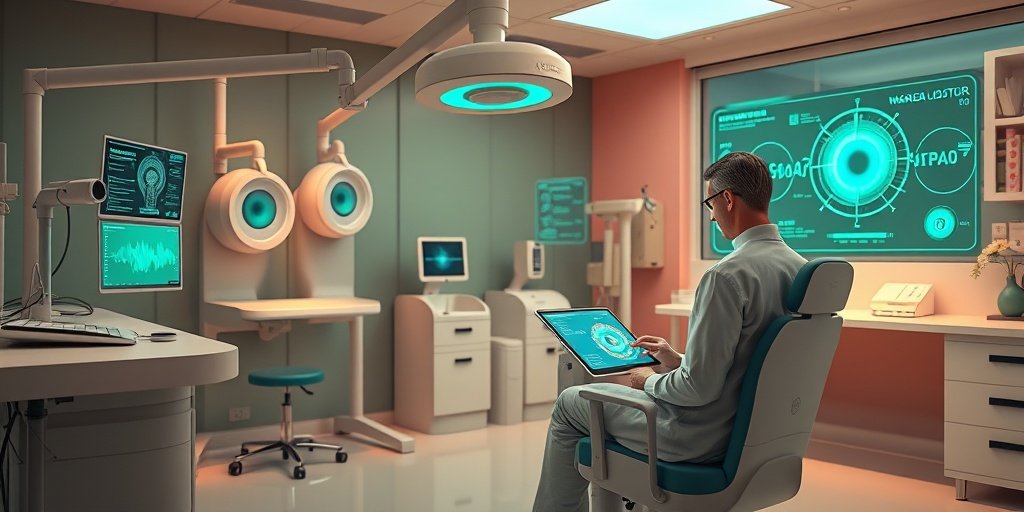⚡ Quick Summary
This study utilized natural language processing (NLP) to identify transportation insecurity in ophthalmology clinic notes, analyzing over 1.8 million clinical notes from 118,518 unique patients. The findings revealed that 0.6% of patients faced transportation challenges, highlighting the potential of NLP in improving patient care access.
🔍 Key Details
- 📊 Dataset: 1,801,572 clinical notes from 118,518 patients
- 🧩 Features used: Free-text clinical documentation
- ⚙️ Technology: Rule-based NLP algorithm
- 🏆 Performance: Precision 0.860, Recall 0.960, F1-score 0.778
🔑 Key Takeaways
- 🚗 Transportation insecurity is a significant barrier to accessing eye care.
- 💡 NLP can effectively identify patients facing transportation challenges in free-text notes.
- 📈 High performance of the NLP algorithm indicates its reliability in clinical settings.
- 👵 Older patients (≥80 years) are more likely to experience transportation insecurity.
- 🌍 Asian patients were significantly less likely to report transportation issues compared to White patients.
- ⚖️ No significant differences were found based on sex or between Black and White patients.
- 🔗 Potential for referrals to transportation resources can improve patient access to care.

📚 Background
Access to eye care is crucial for maintaining visual health, yet many patients face barriers that hinder their ability to receive necessary treatments. One such barrier is transportation insecurity, which can lead to poorer visual outcomes. Traditional methods of capturing this information in electronic health records often fall short, making it essential to explore alternative approaches, such as analyzing free-text clinical notes.
🗒️ Study
This retrospective, cross-sectional study was conducted at a tertiary academic eye center, examining clinical notes from adult patients between 2016 and 2023. The researchers developed a rule-based NLP algorithm to identify mentions of transportation insecurity in the free-text notes, validating its performance against a gold-standard expert review.
📈 Results
Out of the analyzed clinical notes, the NLP algorithm successfully identified 726 patients (0.6%) experiencing transportation insecurity. The algorithm demonstrated impressive metrics with a precision of 0.860, recall of 0.960, and an F1-score of 0.778, indicating a strong agreement with expert evaluations. Notably, older patients were significantly more likely to report transportation issues, while Asian patients showed a markedly lower likelihood compared to their White counterparts.
🌍 Impact and Implications
The implications of this study are profound. By leveraging NLP to identify transportation insecurity, healthcare providers can better understand and address the needs of their patients. This approach not only enhances the identification of at-risk individuals but also facilitates referrals to essential transportation resources, ultimately improving access to eye care and patient outcomes. The integration of such technologies could pave the way for more comprehensive patient support systems in various healthcare settings.
🔮 Conclusion
This study highlights the transformative potential of natural language processing in identifying transportation needs within ophthalmology. By effectively capturing critical information from free-text notes, NLP can play a vital role in enhancing patient care access. As we continue to explore the capabilities of AI and machine learning in healthcare, the future looks promising for improving patient outcomes through innovative solutions.
💬 Your comments
What are your thoughts on the use of NLP in identifying transportation needs in healthcare? We would love to hear your insights! 💬 Join the conversation in the comments below or connect with us on social media:
Identifying Transportation Needs in Ophthalmology Clinic Notes Using Natural Language Processing: Retrospective, Cross-Sectional Study.
Abstract
BACKGROUND: Transportation insecurity is a known barrier to accessing eye care and is associated with poorer visual outcomes for patients. However, its mention is seldom captured in structured data fields in electronic health records, limiting efforts to identify and support affected patients. Free-text clinical documentation may more efficiently capture information on transportation-related challenges than structured data.
OBJECTIVE: In this study, we aimed to identify mention of transportation insecurity in free-text ophthalmology clinic notes using natural language processing (NLP).
METHODS: In this retrospective, cross-sectional study, we examined ophthalmology clinic notes of adult patients with an encounter at a tertiary academic eye center from 2016 to 2023. Demographic information and free text from clinical notes were extracted from electronic health records and deidentified for analysis. Free text was used to develop a rule-based NLP algorithm to identify transportation insecurity. The NLP algorithm was trained and validated using a gold-standard expert review, and precision, recall, and F1-scores were used to evaluate the algorithm’s performance. Logistic regression evaluated associations between demographics and transportation insecurity.
RESULTS: A total of 1,801,572 clinical notes of 118,518 unique patients were examined, and the NLP algorithm identified 726 (0.6%) patients with transportation insecurity. The algorithm’s precision, recall, and F1-score were 0.860, 0.960, and 0.778, respectively, indicating high agreement with the gold-standard expert review. Patients with identified transportation insecurity were more likely to be older (OR 3.01, 95% CI 2.38-3.78 for those aged ≥80 vs 18-60 y) and less likely to identify as Asian (OR 0.04, 95% CI 0-0.18 for Asian patients vs White patients). There was no difference by sex (OR 1.13, 95% CI 0.97-1.31) or between the Black and White races (OR 0.98, 95% CI 0.79-1.22).
CONCLUSIONS: NLP has the potential to identify patients experiencing transportation insecurity from ophthalmology clinic notes, which may help to facilitate referrals to transportation resources.
Author: [‘Wasser LM’, ‘Liang HW’, ‘Li C’, ‘Cassidy J’, ‘Tallapaneni P’, ‘Osterhoudt H’, ‘Wang Y’, ‘Williams AM’]
Journal: JMIR Med Inform
Citation: Wasser LM, et al. Identifying Transportation Needs in Ophthalmology Clinic Notes Using Natural Language Processing: Retrospective, Cross-Sectional Study. Identifying Transportation Needs in Ophthalmology Clinic Notes Using Natural Language Processing: Retrospective, Cross-Sectional Study. 2025; 13:e69216. doi: 10.2196/69216